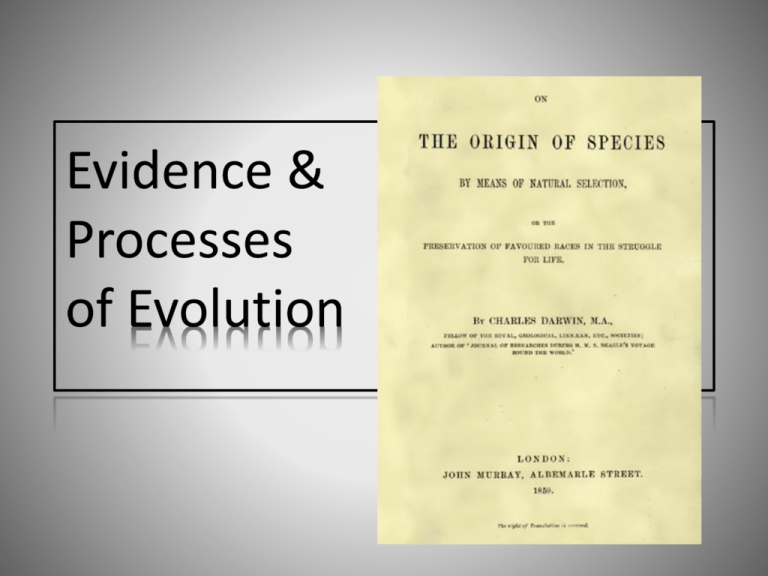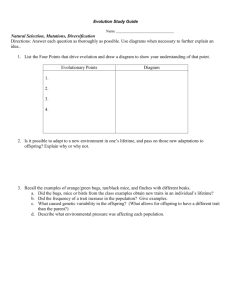Notes - Evolution 2015 - Willimon-PHS
advertisement

Processes of Evolution – Summary Allele Frequency • Allele Frequency – the number of alleles for a specific trait that occur in a population •Ex. The number of A’s vs a’s • Natural selection shifts the phenotypic distribution away from the phenotype that is selected against Mechanisms of Evolution Natural Selection “survival of the fittest” Mutations create new alleles Migration moves alleles into and out of a population Genetic drift happens when random events change the allele frequencies of small populations Sexual Selection (non-random mating) Natural Selection http://www.youtube.com/watch?v=aTftyFboC_M Species A group of organisms that can interbreed in nature and produce fertile offspring Speciation – How New Species Form Must be isolated from other populations for a long period of time. different selection pressures cause different traits to be selected for or against. http://www.youtube.com/watch?v=2oKlKmrbLoU Geographic Isolation • Species are separated from each other by a physical barrier Geographic Isolation • The Kaibab and Albert squirrels are separated by the Grand Canyon Behavioral Isolation • Species cannot interbreed because they have different mating rituals or behavior Temporal Isolation • Species mate at different times of the day or the year Mass Extinctions • When many species disappeared from the Earth •Provides opportunity for new species to evolve and establish themselves • Mammals might not have “taken over” if the dinosaurs hadn’t gone extinct! Adaptive Radiation • A single species evolves into many species • Occurs as new opportunities for survival arise Convergent Evolution • Unrelated organisms begin to look like each other because of similar selection pressures • These organisms would have analogous structures Convergent Evolution • Sharks (fish) and dolphins (mammals) have evolved similar adaptations because of similar selective pressures Coevolution • When two species evolve together in response to changes in each other • Example: Bees and Flowers Evidences of Evolution Homologous Structures Similar body structures that are adapted in different ways for different organisms Provide evidence that related organisms descended, with modifications, from a common ancestor Vestigial Structures The structures of organisms that remain from a common ancestor, but may no longer affect its ability to survive and reproduce Example: Appendix, Tail Bone Analogous Structures Unrelated organisms in similar environments develop similar adaptations. Example: Flight of Insects vs. Birds vs. Bats Fossil Record The fossilized remains of organisms found in the layers of rock and soil Shows that the diversity of organisms has changed over time Embryology Organisms with a common ancestor share similar stages of development. DNA Analysis All organisms use the same four bases for their DNA (genetic code). The more similar two sequences of DNA are, the more recent their common ancestor, or the more closely related the organisms are. DNA Analysis • Modern biologists compare DNA sequences to determine which organisms are most-closely related to each other





